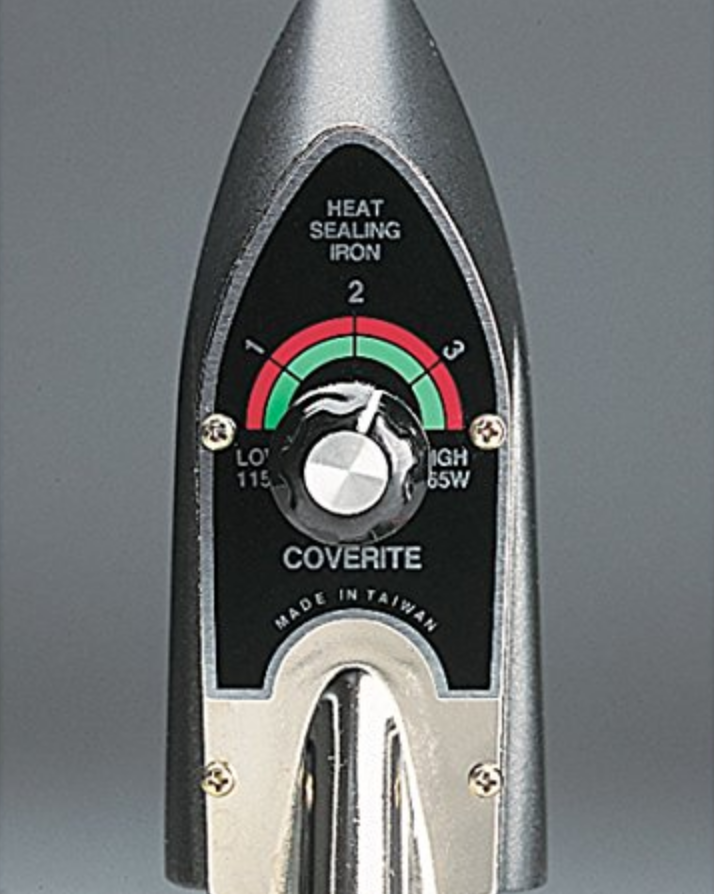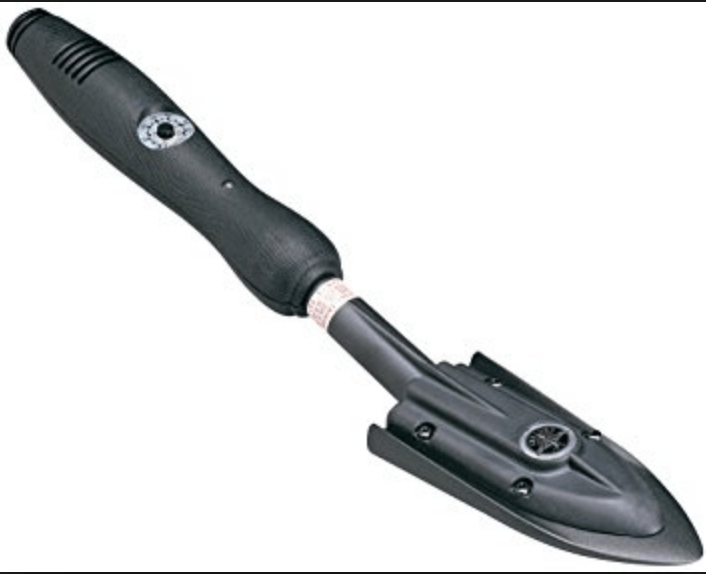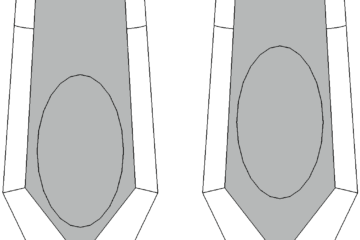A number of people have experienced temperature problems with mini irons like the Clover Mini Iron II and the Dritz Petite Press, so I am designing future DIY Packrafts to be easier to make using larger hobby irons like the Coverite Black Baron sealing iron, pictured above.
Irons like this are designed for heat sealing the plastic skin onto radio controlled airplanes, and they’re available in every hobby shop that sells RC airplane kits (and many places online, of course). They’re inexpensive (generally $20-$30 USD), robustly built, and unlike the mini irons, which have limited temperature control, model airplane irons typically feature a rheostat for controlling the temperature, allowing you to dial in an exact temperature. (They don’t have accurate temperature gauges built in, so finding the right temperature must be done by trial and error, but once you’ve found the right setting you can set the dial and forget it.)
When I built my first RC airplane in the mid-1990s, a friend gave me his old Top Flite Sealing Iron. I don’t know when he bought it, but it was at least several years old then and it still works perfectly more than two decades later. Top Flite is still making an iron that looks exactly the same (pictured below). I can’t recommend it though, because it has an annoying design flaw: the metal top plate (held on by four screws) overhangs the vertical sides just enough to prevent you from being able to use the sides of the iron for heat sealing.

That’s why I recently bought a Coverite Black Baron heat sealing iron. You can see in the picture below how the sides of the Black Baron protrude far beyond the top plate; the rounded side design isn’t ideal for making packrafts, but it works pretty well, and most of the ironing is done with the bottom of the iron anyway.

I’ve been using the Black Baron for a while now and I’m quite happy with it. The ideal temperature for heat sealing the DIY Packraft fabrics is towards the high end of the range, but it’s not maxed out, and the non-stick coating allows it to slide nicely over the fabric even when applying pressure.
There are other brands of model airplane heat sealing irons too, and they’re probably just as good, so if you’re struggling to find a heat sealing iron that works for you, visit your local hobby shop and pick one up.
Note that a few manufacturers of these model airplane irons also make “trim” sealing irons with smaller feet designed for heat sealing small areas. These do not get hot enough to seal TPU coated fabric so should be avoided.

Trim sealing irons are not hot enough to activate TPU.
Note: Aside from the Trim Sealing Iron pictured above, there is another model airplane covering iron made by Coverite that (at first glance) looks similar to the Coverite Black Baron, but several people have reported that it does not get hot enough to seal TPU-coated fabrics. It’s the Coverite 21st Century Sealing Iron, pictured below.


15 Comments
Mark · April 11, 2018 at 8:07 am
I recommend against the 21st Century Iron altogether. Mine actually didn’t get hot enough and it lost its heat too quickly due to the shoe having less mass than the Black Baron iron. The 21st Century Iron looks good on paper and I’m sure it’s great for the thin fabrics that airplane modelers use, but for this application I don’t think it’s the right tool.
Matt (Admin) · April 11, 2018 at 8:32 am
Thanks, Mark – I’ve updated the post to include this tip because you’re not the first person to have issues with the 21st Century iron. Cheers
Brian W Henson · April 9, 2018 at 8:36 pm
I’m not sure what is going on but I’ve had TWO 21st century irons catch on fire the second one worked at first but like the first got so hot it burnt the sock off and flammed up where I had to get it out side and the stink is horrible. I took the first one back to my hobby supply store and he happily gave me a replacement but I’m reluctant to go back he might think I’m doing something funny so what should I do???
Matt (Admin) · April 9, 2018 at 9:46 pm
Yikes, that sounds scary! I’ve never used a sock, so maybe that’s the issue – wrapping an iron in an insulating blanket will certainly keep a lot more heat in. I’d avoid using a sock in the future.
Grant · January 4, 2018 at 2:40 pm
Patrick, any news/reviews of the 21st century iron yet?
they are leagues ahead of everything else based on the comments here: https://www.towerhobbies.com/cgi-bin/WTI0001P?I=LXB361#BVRRContainer
The main reason I ask, is that they have a 220/240V version. and I know in many blogs people say that irons outside the USA dont get hot enough… so this may be the solution? I might finally be able to get a DIY packraft if it works well!
Ron Samber · November 18, 2017 at 8:28 pm
In the last 12 months, I have built 4 cat-a-rafts and experimented with a few small pillows as well. I had 2 failed attempts, one reasonably functional raft and finally arrived at a design I am happy with. The point of that is that I have sealed a bunch of linear feet of fabric.
I started with the Mini Clover and graduated to the “improved” mini clover. (aluminum foil wrapped shaft) The out of the box version is painfully slow on 210 D fabric. The improved version is significantly better but it still requires waiting. It heats up to where it melts on contact (not good) then cools to where it’s not sealing requiring one to wait for it to heat up. Wait too long and it melts on contact. Not long enough and you don’t get much sealing done. The mini Clover does work much better with the lighter fabrics but they melt much easier when the iron is too hot so greater care is required.
Recently, I have been struggling with getting a pillow to hold air overnight with weight on it. If I can do that then I can build a raft that stays hard for long periods… I considered that the problem might be the new batch of fabric – especially the new 3 oz 40D. I mostly suspected my technique. I thought that I might be weakening the fabric at the seam edge when I hit it with a too hot iron. I suspected I was causing just enough damage to allow a very small amount of air seepage. As soon as I saw the video of Matt with the Black Baron I ordered it on Amazon. It was $26. As soon as it arrived I cut off the edges and resealed my last two pillow experiments. I achieved a good seal and no leakage. I put a 10″ x 10″ x 3/8″ steel plate on top of my most recent 40D experiment and it held air overnight. Mystery solved. I am now waiting for another batch of fabric and looking forward to working with the Black Baron iron. It is much more robust than the Mini. I broke my first Mini Clover after a decent amount of use and my current one is loosening up and likely to break in the near future. I don’t see how one could break the Baron. The adjustable temperature really helps and the larger mass holds the heat. As noted above, the Baron’s size helps solve some issues but at times can be a hindrance but overall, I think we are on to something here. Ron Samber
Patrick · October 26, 2017 at 10:51 pm
How much power you want depends on how much area you want to weld at once. A soldering iron may melt the material together, but when a complete boat consists of maybe a square meter of welding, the tip of a soldering iron makes maddeningly slow progress.
I have experimented with various soldering irons attached to a rheostat, an antique one with a big chunky copper tip worked the best. I also tried the clover iron, it gets the job done but is still slow at 40W. The whole thing of having a heating element far from the iron surface is maddening, as you are relying on all the heat you need for bringing fabric and underlayment up to temperature to travel down a skinny shaft. In addition, having this “lag” between your heat source and sealing surface makes for an iron that when laying about overheats, but when used cannot produce enough heat to weld efficiently. For example, the clover must be left sitting idle on it’s medium setting as to not get the tip hot enough to melt the nylon at initial touch. however, once in use it must be turned up to it’s highest setting to keep up with heat lost through the tip.
Matt’s suggestion of using the black baron heat sealing iron makes sense, as the heating coil is in the iron itself, and it appears to have at least a little thermal mass to it. I.e, the heat you make is the heat you get at the tip. I am waiting for the “21st century” cover rite iron to come in the mail, supposedly it keeps a temperature within 3 deg f.
I would rather use a clothing iron before I used a soldering iron!
Matt (Admin) · October 27, 2017 at 8:47 am
Excellent points, Patrick. I made an aluminum foot for my soldering iron so it had more thermal mass and it worked pretty well, but the tools required and the amount of work involved in shaping the aluminum makes that approach impractical for most people – it’s so much easier to buy something that works out of the box!
Please let us know how you like the 21st Century iron. Cheers!
waldlaeufer.5105 · October 8, 2017 at 1:17 pm
hello,
how much power you need for welding the tpu?
are 20W enough?
in germany i can get an iron which will make 240 till 280 grad celsius.
Matt (Admin) · October 8, 2017 at 3:06 pm
I have used a 20W soldering iron and it worked fine – it sounds like that iron will work if the advertised temperature is accurate.
Bruce Campbell · August 19, 2017 at 12:05 am
Matt,
Before you wrote this blog, I decided to try one of the model aircraft heat sealing irons. I chose the Top Flight because it has a narrower bottom, and I thought it might be useful sealing across double width seams, where tubes join the floor, for example.
Using my inexpensive infrared thermometer (an instant read oven meat thermometer works just fine too) I found it heated to 198 degrees C. On removing the plastic thermostat knob, I could reach into the brass stem with a fine jewelers slotted screwdriver and adjust the thermostat. Turning the inner screw counter-clockwise increases the temperature. It doesn’t take much. 1/8 of a turn may be all you need. Double check it on a piece of TPU fabric, of course. I’ll post a picture on the forum.
I have also ordered one of the 220 volt leather irons from Aliexpress. I’ll let you know its dimensions and how it works when it arrives.
Greg Luther · July 28, 2017 at 12:44 pm
Hey Matt –
Having used both the Coverite Black Baron and the Clover Mini Iron II, do you have thoughts ultimately on which is a better tool for building a packraft? It seems like they all have certain tradeoffs, but is this the best so far? You thoughts are much appreciated!
Greg
Matt (Admin) · July 28, 2017 at 4:57 pm
Hi Greg,
I think this is a better product in general, but its size makes it a bit awkward to use sometimes, so it’s a trade-off. Future DIY Packrafts will be designed to be easier to construct with irons this size.
Cheers!
Michael · October 24, 2017 at 2:44 pm
Hey Matt,
It looks like the Black Baron is larger—something like 4-5 cm wide—and you recommend strips be ~2.25 cm wide (according to the v2 tutorial videos). Did you just use the side of this iron? Or cut wider strips?
Matt (Admin) · October 25, 2017 at 10:25 am
Hi Michael – I use the side and the bottom and the tip of the iron when working on the seams, depending on the situation. You can iron a strip narrower than the bottom of the iron by ironing over a convex bowl or narrower form (details in the V3 instructions), and you can also try putting masking tape on parts of the iron to insulate areas you don’t want to use. Cheers!